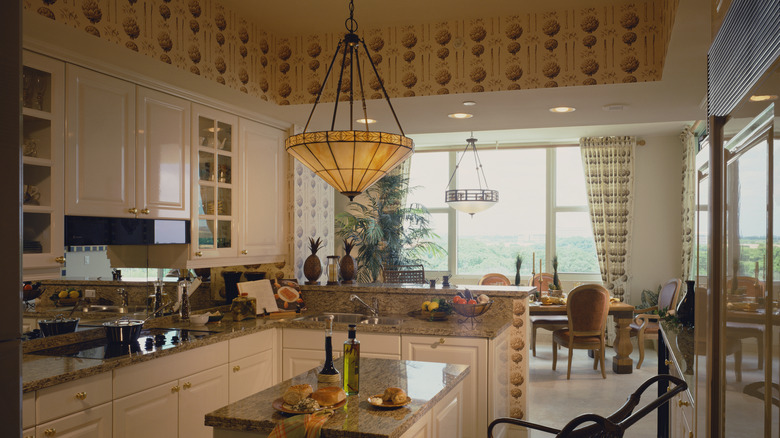This Outdated Kitchen Trend Is Finally Making A Comeback, Here's Why
For many years, the sleek, white kitchen was the popular style in home design. Many homeowners designed their kitchen with neutral subway tile and stainless steel, but the desire for a modern look often resulted in a space that felt more utilitarian than welcoming. If you're tired of that plain look, there's some great news: The once outdated 1990s kitchen wallpaper look is back in. This throwback is an excellent solution for homeowners who want to boost the charm and warmth in their space. Wallpaper quickly softens a kitchen by adding a layer of texture, color, and personality that paint and tile just can't recreate.
The past decade has seen a shift toward minimalist materials like steel, gray tones, and plain walls, but the pendulum is now swinging back towards a more homey feel. Wallpaper can be a budget-friendly way to update and change a kitchen compared to the cost of replacing cabinets or countertops. The number of prints to choose from allows homeowners to express their style in a way that goes beyond just changing a paint color. Many people are rediscovering the appeal of a stylish, lived-in space over one that looks like a showroom. If you're looking for wallpaper ideas that will add charm to your home, using wallpaper on an accent wall or throughout the entire room creates a welcoming environment, and a repeated pattern can change a room's atmosphere to one that feels warm and full of personality.
The best 1990s wallpaper patterns for adding softness and warmth
If you're looking for tips for picking the perfect wallpaper, remember that the design style during the '90s prioritized comfort while still allowing for creativity and color. You should look for patterns that introduce a texture or a romantic feel to your walls to really take advantage of this style. Cottage chic florals were all the rage, pulling inspiration from American prairie and classic English prints. The soft pastel color palette that was popular then will make a room look dated, so use more updated colors such as warm off-white, soft gray, or deep navy and pair them with richer, muted accent colors such as sage green, dusty rose, or terracotta.
Another great option for adding an organic touch is using wicker or caning-inspired patterns. The '90s love for natural textures like rattan and wicker is having a comeback in wall coverings, with patterns that mimic these types of materials. These textured papers provide a natural element that adds warmth. Shiny gold and silver details are making a return in wallpaper, but the modern look is less gaudy and more refined. These metallic touches are now layered into papers with subtle texture to add a soft glow. Even the wallpaper border is making a comeback, although not in the kitschy, themed styles that were popular. The modern usage involves using tone-on-tone or monochromatic patterns to frame ceilings or highlight architectural elements. Using a pattern on the walls helps add depth and prevents the space from feeling too plain. Some homeowners have been adding patterned wallpaper to their backsplash, around their kitchen island, or on an accent wall.
How to find a kitchen wallpaper that is durable against moisture
Many people aren't sure if they should use wallpaper in their kitchen because they're concerned about water, grease, and heat, but modern wallpapers have made this a non-issue. Look for durable, scrubbable wallpaper that's designed for high-moisture areas like kitchens and bathrooms. The most popular choice is vinyl wallpaper, which has a plastic coating that stops moisture from getting through the paper to the wall underneath.
Newer peel-and-stick wallpapers are also good for creative DIY ideas because they're often made from a removable waterproof vinyl, which makes them easier to clean. Many wallpaper makers warn against using them near excessive water or open flames, so if you really want to wallpaper the area behind your sink or stove, you can protect it with a clear, tempered glass or acrylic panel. Another option is to coat non-vinyl wallpaper with a clear wallpaper sealant or varnish to create a water-resistant barrier. Preparing the wall prior to installation is also important, so make sure you install wallpaper on a completely dry, clean wall using a water-resistant adhesive to prevent any peeling or bubbling.


